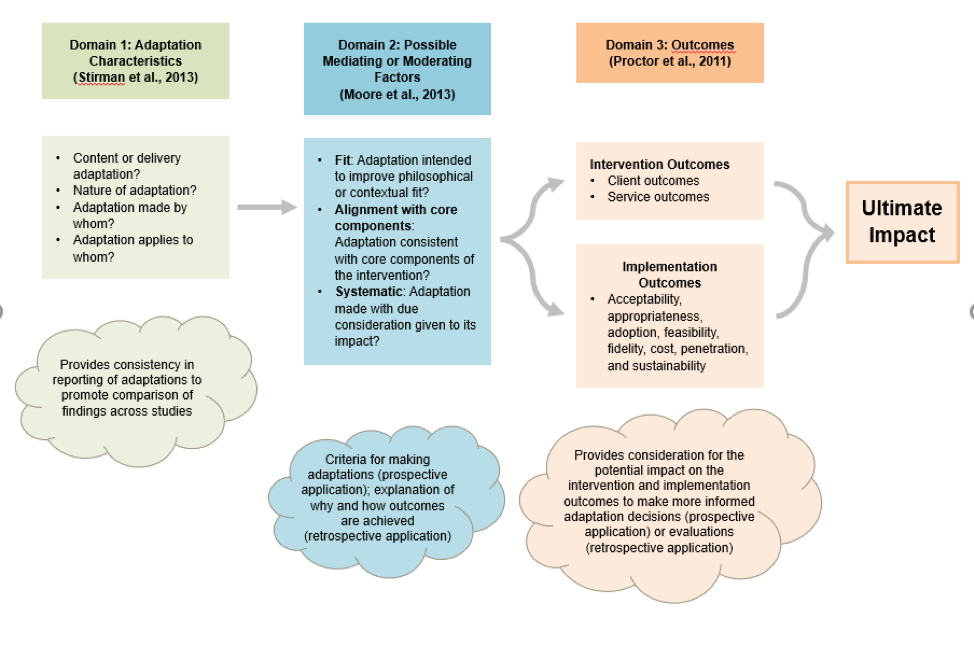The Model for Adaptation Design and Impact (MADI): A Solution for Practical Implementation
By Dr. Julia E. Moore, Executive Director
I was first trained an implementation scientist in the United States, where I was taught that the evidence-based program must be implanted with absolute fidelity. These programs had been rigorously tested under certain conditions and shown to be effective; therefore, we change as little as possible to ensure success in real-world implementation.
As I began working on large scale implementation efforts, fidelity was seen as the ideal but was so far from the reality of what was happening. I was left believing that we should strive for fidelity, but accept that adaptations were a reality.
When I returned to Canada, the conversation was totally different. Everyone emphasized the need for adaptations at every level. There was a deep recognition that settings and populations were different and programs needed to be adapted to meet local needs.
After working on dozens of implementation projects, I am convinced that adaptation is required. But we are not optimizing how we adapt programs. We are making adaptations on a whim, reactively, without strategy and forethought.
We have an amazing opportunity right now to rethink how we adapt programs. If we embark on implementation knowing that adaptation is inevitable and often required, we can proactively plan for the kinds of adaptations we are going to make. This will allow us to consider the potential positive and negative impacts that different kinds of adaptations may have on program outcomes.
Most of the high quality adaptations I have seen or been a part of relate to getting buy-in from your target audience by making the program culturally and/or logistically relevant. Adaptations such as these encourage people to show up to the table; without them, people may not show up at all. The drawback of making adaptations is that we get into the mindset that it is okay to adapt and change whatever we want, whenever we want. This is not true. The reason evidence-based programs are evidence-based is because there is evidence of their effectiveness and underlying theory to predict the mechanism of change. Our goal in making adaptations should be to enhance buy-in, improve equity and access, improve the user experience, while trying to leave the underlying evidence and mechanisms of change untouched.
A great example of this is when we have role plays in education sessions. Facilitating a role play is very challenging and not always welcomed by participants. So it is one of the most common elements of education session that we remove. But role plays are about skill building and confidence building. Education is about increasing knowledge. If the underlying barriers and facilitators to change have to do with people’s confidence, and you remove the role play element, you have altered the underlying mechanism of change – potentially altering the effectiveness of a program.
So our goal is not to have 100% fidelity to all program components. Instead, how can we proactively consider the kinds of adaptations that will be needed, and weigh the advantages against the potential detrimental effects of altering the mechanism of change?
Alexis Kirk’s project spotlight below introduces a consolidated framework for considering how we can make adaptations without affecting the mechanism of change.
The Model for Adaptation Design and Impact (MADI)
By Alexis Kirk, Research Health Analyst, RTI International
The realities of adapting evidence-based interventions on the ground necessitate that implementation practitioners and researchers have structured conversation about the risks and benefits of adaptations. Engaging in “real-world” adaption, we found a need for a framework that could help implementers think through various “ripple effects” that adaptations could have (e.g., instances where an adaptation may help improve acceptability, but may decrease fidelity). Such a framework could help implementers systematically assess tradeoffs so that they can either re-tool proposed adaptations, carefully monitor impacts on selected outcomes for adverse effects, and/or develop implementation strategies to offset potential negative impacts of adaptations.
The Adaptation-Impact Framework, which is a consolidated framework of three pre-eminent frameworks in the field (Stirman et al., 2013; Moore et al., 2013; Proctor et al., 2013) can be applied by implementers prospectively or retrospectively to guide discussions.
Retrospectively, application of the framework is straightforward: you classify adaptations using constructs in Domain 1 (Adaptation characteristics). Then, you use constructs in Domains 2 and 3 to help choose possible mediators/moderators/outcomes.
Prospectively, the Adaptation-Impact framework can guide an iterative adaptation process. As a first step, you can use constructs in Domain 2 to help explore the likelihood an adaptation will have negative impacts. If an adaptation is not systematic, detracts from core components, or is not designed to improve fit, that increases the likelihood of overall negative impact and implementers should re-think the adaptation. Second, we recommend implementers consider the impact an adaptation could have on all of the outcomes listed in Domain 3. This will help implementers identify the full array of ripple effects an adaptation could have to systematically consider tradeoffs (e.g., whether a decrement in fidelity might be offset by an increase in reach). Finally, you can classify adaptations using constructs from Domain 1 to promote consistent, standardized terminology in the field.
These articles were featured in our monthly Implementation in Action bulletin! Want to receive our next issue? Subscribe here.

